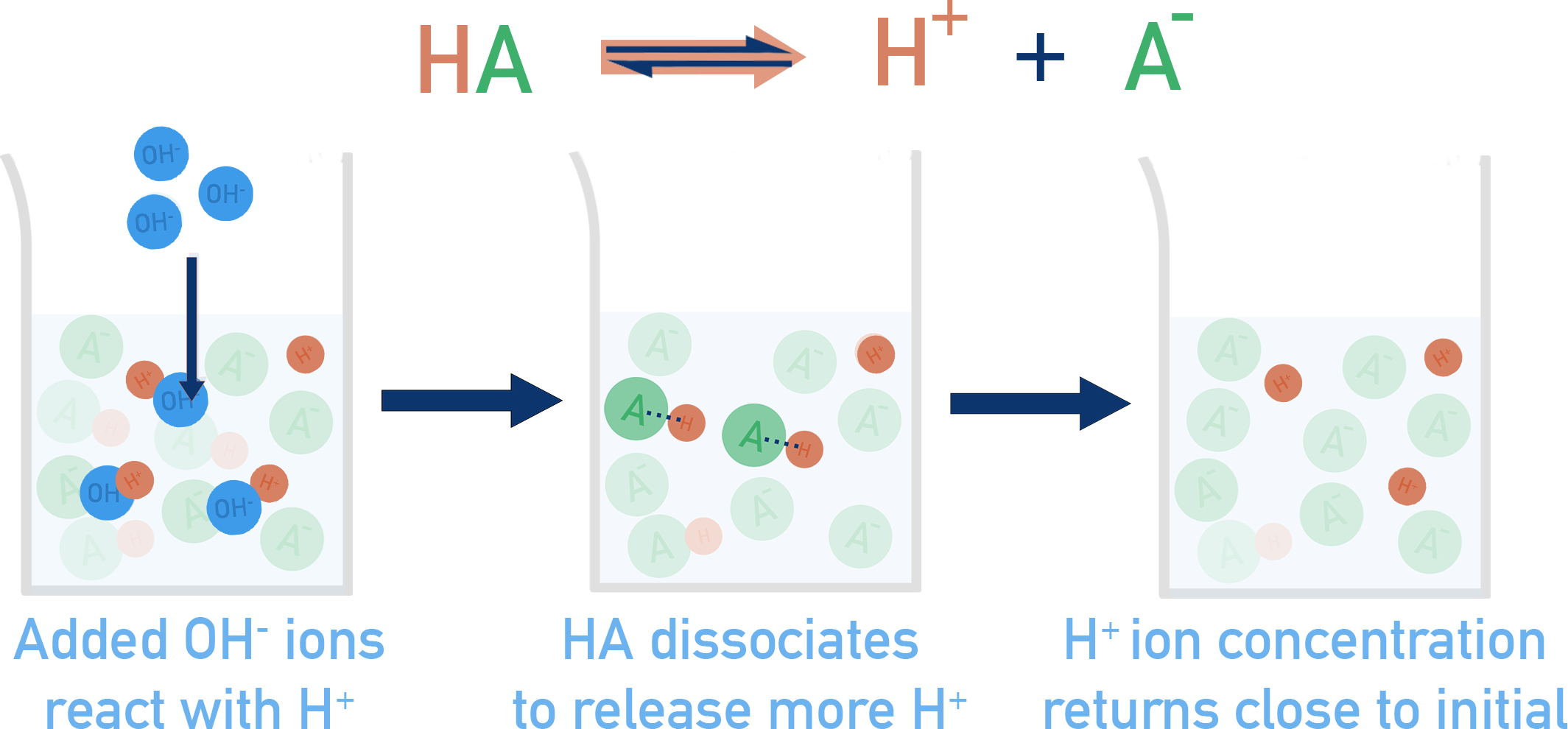Properties of Buffers
Quick Notes
- Buffers resist changes in pH when small amounts of acid or base are added.
- A buffer contains a conjugate acid-base pair: a weak acid (HA) and its conjugate base (A−), or a weak base (B) and its conjugate acid (BH+).
- The acid neutralizes added base, and the base neutralizes added acid.
Full Notes
What is a Buffer?
A buffer is a solution that resists changes in pH when small amounts of acid or base are added. Buffers work by having both a weak acid and its conjugate base (or a weak base and its conjugate acid) in equilibrium.
Types of Buffer Systems
1. Acidic Buffers: Made from a weak acid and its salt (that contains the acid’s conjugate base).
For Example: The weak acid ethanoic acid (CH3COOH) and its salt sodium ethanoate (CH3COONa).

You can also prepare a buffer by reacting a weak acid with a limited amount of strong base, such as:
CH3COOH + NaOH → CH3COONa + H2O
This produces both HA and A− in the same solution.
2. Basic Buffers: Made from a weak base and its salt (that contains the conjugate acid of the base).
For example The weak base ammonia (NH3) and its salt ammonium chloride (NH4Cl).

When added to a solution of ammonia, the NH4Cl would dissociate and release NH4+ ions, which are the conjugate acid ions of the ammonia.
How Do Acidic Buffers Work?
An equilibrium is established in the buffer system between HA, A− and H+.

The concentration of HA and A− in the mixture must be much greater than the concentration of H+. This ensures the equilibrium is sensitive to H+ changes more than HA or A−. Equilibrium can shift to keep [H+] nearly constant.
Example: Ethanoic Acid/Sodium Ethanoate Buffer (CH3COOH/CH3COO−)
Equilibrium reaction:
CH3COOH ⇌ H+ + CH3COO−

When an acid (H+) is added:
- CH3COO− combines with added H+ to form CH3COOH.
- Equilibrium shifts left, reducing the increase in H+.
- [HA] increases and [A−] decreases.
When a base (OH−) is added:

- Added OH− reacts with H+ to form H2O.
- CH3COOH dissociates more to replace lost H+.
- Equilibrium shifts right, resisting pH increase.
- [HA] decreases and [A−] increases.
As long as there are significant amounts of HA and A− present, this system can buffer against pH changes.

Remember that the concentration of HA and A− will change when H+ or OH− are added. When H+ ions are added then moles of HA increase and moles of A− decrease. When OH− ions are added then moles of HA decrease and moles of A− increase.
Q: What happens to the pH when a small amount of NaOH is added to a buffer made of 0.10 M CH3COOH and 0.10 M CH3COO−?
- Set up & assumptions
Take 1.00 L of buffer so initial moles are CH3COOH (HA) = 0.10 mol and CH3COO− (A−) = 0.10 mol. Add 0.010 mol NaOH (small amount). Assume volume change is negligible. - Neutralization reaction (stoichiometry)
OH− + HA → A− + H2O
New moles: HA = 0.10 − 0.010 = 0.090 mol; A− = 0.10 + 0.010 = 0.110 mol; OH− is fully consumed. - pH before addition (Henderson–Hasselbalch)
pH = pKa + log([A−]/[HA]) = 4.76 + log(0.10/0.10) = 4.76. - pH after addition
[HA] ≈ 0.090 M; [A−] ≈ 0.110 M (1.00 L total).
pH = 4.76 + log(0.110/0.090) = 4.76 + log(1.22) ≈ 4.76 + 0.087 = 4.85.
A: The added OH− reacts with CH3COOH:
CH3COOH + OH− → CH3COO− + H2O.
CH3COOH decreases to 0.090 M and CH3COO− increases to 0.110 M. Using Henderson–Hasselbalch, the pH changes only slightly: 4.76 → 4.85 (ΔpH ≈ +0.09), demonstrating buffer action.
Why Weak Acids and Bases Are Needed
Weak acids and bases only partially dissociate, setting up an equilibrium with their conjugates. This equilibrium helps them resist changes in pH by reacting with added H+ or OH−.
Strong acids and bases fully dissociate, so they can’t maintain this balance — meaning they can’t act as buffers.
Buffer Capacity
Buffer capacity is the amount of acid or base the buffer can absorb without a significant pH change. It depends on the absolute concentrations of HA and A− and therefore the ratio [A−]/[HA]
Buffers are most effective when [HA] ≈ [A−] and this happens when pH ≈ pKa.
Summary
- Buffers stabilize pH through neutralization reactions.
- They rely on conjugate acid-base pairs to absorb added H+ or OH−.
- Their effectiveness is greatest when pH ≈ pKa.
